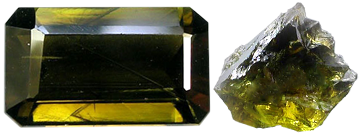 Photo of Epidote in Processed & Rough Form
Photo of Epidote in Processed & Rough Form
Epidote is a mineral with a hardness of 7 out of 10 on the Mohs scale of mineral hardness [?]. These Monoclinicly structured gems are made of calcium aluminum hydrosilicate, their full chemical compound being Ca2(Al,Fe)(SiO4)3.
Epidote is widespread, forms a continuous series of minerals, ending with clinozoisite, which contains no iron.
It occurs as crystals elongated and often striated parallel to length, and also as massive, fibrous, or granular habits.
Epidote has a yellow-green color, ranges from yellowish-greenish to greenish-black. It has vitreous luster, and is transparent to nearly opaque. It has one perfect basal cleavage parallel to the length of crystals.
It fuses with swelling to a black, magnetic glass. It is infusible.
It is common in medium- or low-grade metamorphic rocks which have formed either from calcareous or basic rocks, associated with garnet, diopside, idocrase, and calcite in impure limestones. It occurs in "saussurite," the alteration product of feldspar, and is formed from the alteration of hornblende.
Varieties include "Withamite," a pink, manganese-bearing epidote found in vesicles and veins in andesite, mostly from Italy and metabasites in Cyprus; "Pumpellyite," a widely-distributed, hydrous, epidote-like material, found in low-grade metamorphosed tuffs, and also in the vesicles of ancient lavas; "Pistacite," a pistachio-green variety; "Piemontite," opaque, cherry-red variety, contains manganese, from Piemont (Italy); "Tawmawite," or "Chrome epidote," (mistakenly called "chrome jade," a chromium-bearing variety found in Burma, also in Finland; "Delphinite," yellowish-green from France, sometimes called "oisanite" or "thallite;" "Clinozoisite," a light-green to green-brown variety which is iron-free.
Good to splendid crystals are found in Untersulzbachtal (Austria), "arendalite" from Arendal (Norway), (Isere) France, the Naziamsky mountains (Urals, Soviet Republics). Cuttable qualities are also found in Mexico, Mozambique, California (USA)
Misleading terms include "Burma epidote," which is actually jade-albite from Myanmar (Burma);
It may be mistaken for tourmaline, which lacks cleavage and has a triangular or hexagonal cross-section.
The specific gravity [?] for Epidote is 3.4, its refractive index [?] is 1.74-1.78, and its double refraction [?] is 0.035.
History
Epidote is formed by hydrothermal alteration of plagioclase in gabbros, and in vesicles in basic lava flows. It derives its name from the Greek word "epidosis" meaning "addition."
Industrial Usages
Epidote is occasionally used in jewellery, but is mainly of interest to scientists and collectors.






